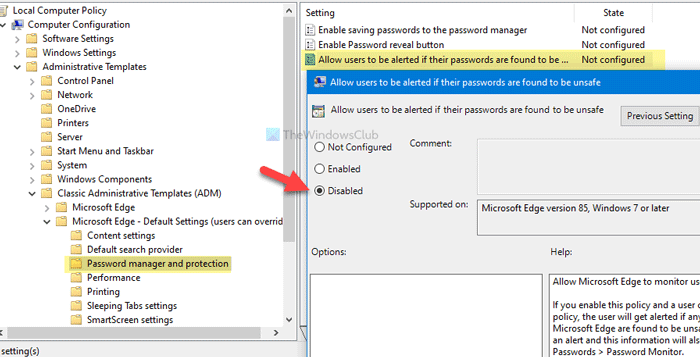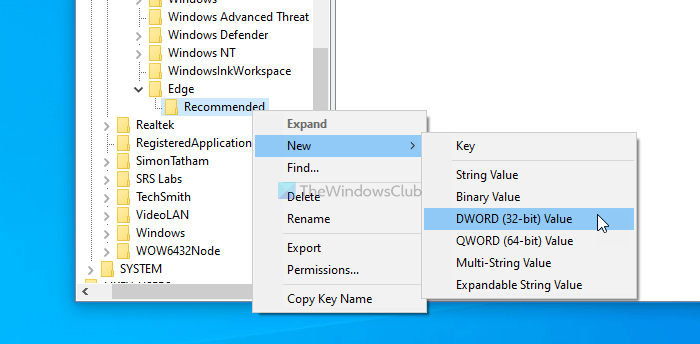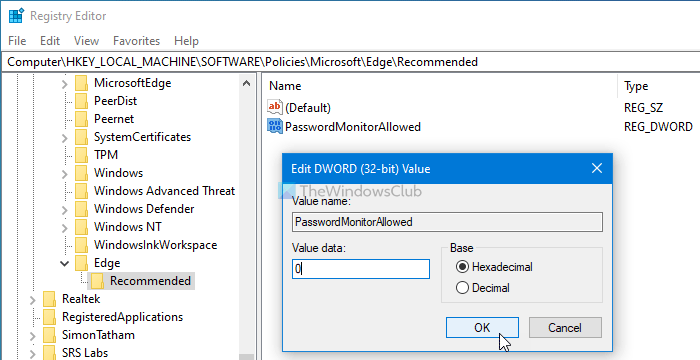Monitoring your passwords is equally important as having a strong password, whether for your Facebook or internet banking account. Thanks for Password Monitor in Edge, which helps users monitor all the saved passwords and notify them in case of a leak. Here is how you can enable or disable Password Monitor in Edge using the b and Local Group Policy Editor.
Now and then, attackers leak massive lists of passwords of various accounts. Your passwords become vulnerable if you use the same password on multiple websites. In that case, having an automatic password monitor helps you a lot.
Turn On or Off Password Monitor in Edge using Group Policy
To enable or disable Password Monitor in Edge using Group Policy, follow these steps-
- Press Win+R to show the Run prompt.
- Type gpedit.msc and hit the Enter button.
- Navigate to Password manager and protection in Computer Configuration.
- Double-click on Allow users to be alerted if their passwords are found to be unsafe setting.
- Select the Disabled option.
- Click the OK button.
Let’s delve into the steps in detail.
Note: It is required to download Group Policy Templates for Microsoft Edge to use the Group Policy method.
At first, press Win+R, type gpedit.msc, and hit the Enter button. Once the Local Group Policy Editor is opened, navigate to the following path-
Computer Configuration > Administrative Templates > Classic Administrative Template > Microsoft Edge - Default Settings > Password manager and protection
You can see a setting called Allow Allow users to be alerted if their passwords are found to be unsafe on your right-hand side. Double-click on it, and select the Disabled option.

At last, click the OK button to save the change.
If you want to re-enable Password Monitor in the Edge browser, open the same setting in the Local Group Policy Editor, choose the Enabled or Not Configured option, and click the OK button.
Note: It is recommended to backup all Registry files to be on the safe side.
Enable or disable Password Monitor in Edge using Registry
To enable or disable Password Monitor in Edge using Registry, follow these steps-
- Press Win+R to open the Run prompt.
- Type regedit and hit the Enter button.
- Click the Yes option.
- Navigate to Microsoft in HKEY_LOCAL_MACHINE.
- Right-click on Microsoft > New > Key.
- Set the name as Edge.
- Right-click on Edge > New > Key.
- Set the name as Recommended.
- Right-click on Recommended > New > DWORD (32) Value.
- Name it as PasswordMonitorAllowed.
- Keep the Value data as 0.
To learn more about these steps, keep reading.
At first, press Win+R, type regedit, and hit the Enter button. It shows the User Account Control window. If so, click the Yes button to open the Registry Editor on your computer. After that, navigate to the following path-
HKEY_LOCAL_MACHINESOFTWAREPoliciesMicrosoft
Here you have to create two keys. For that, right-click on Microsoft, select New > Key, and set the name as Edge. Then, right-click on the Edge key, select the New > Key option, and call it Recommended.

After that, right-click on Recommended and choose the New > DWORD (32-bit) Value, and name it as PasswordMonitorAllowed.

By default, the Value data is set as 0, and you have to keep it that way to turn off Password Monitor in the Microsoft Edge browser.

However, if you want to enable Password Monitor, navigate to the same path, double-click on the PasswordMonitorAllowed DWORD value, and set the Value data as 1. Alternatively, you can delete the Edge key from Microsoft as well.
That’s all!
